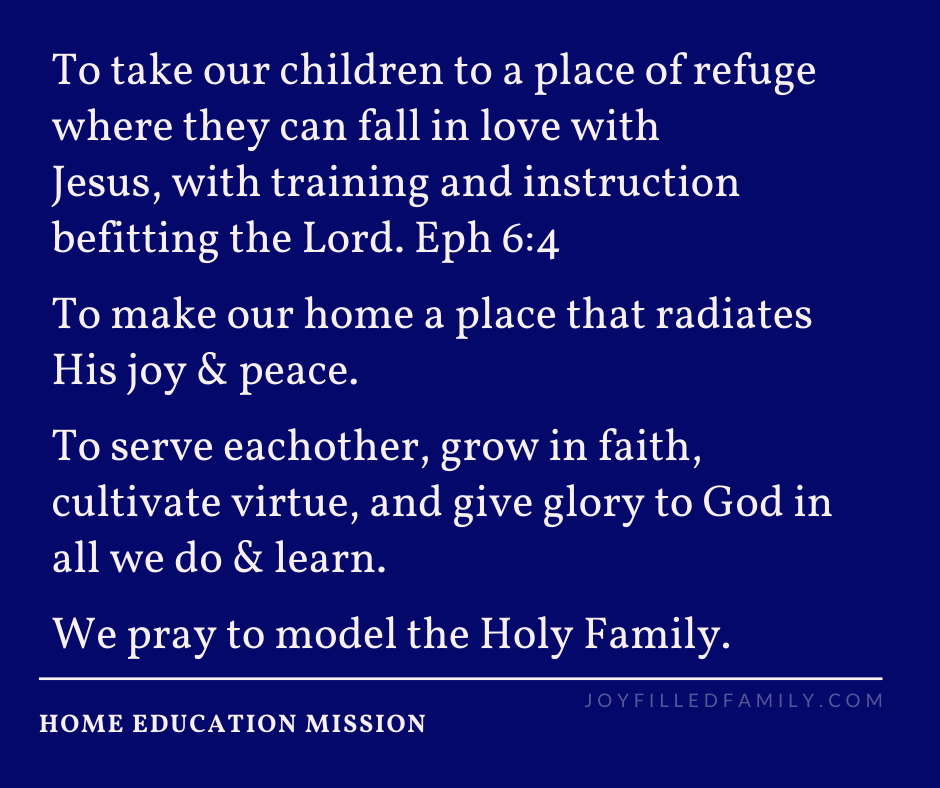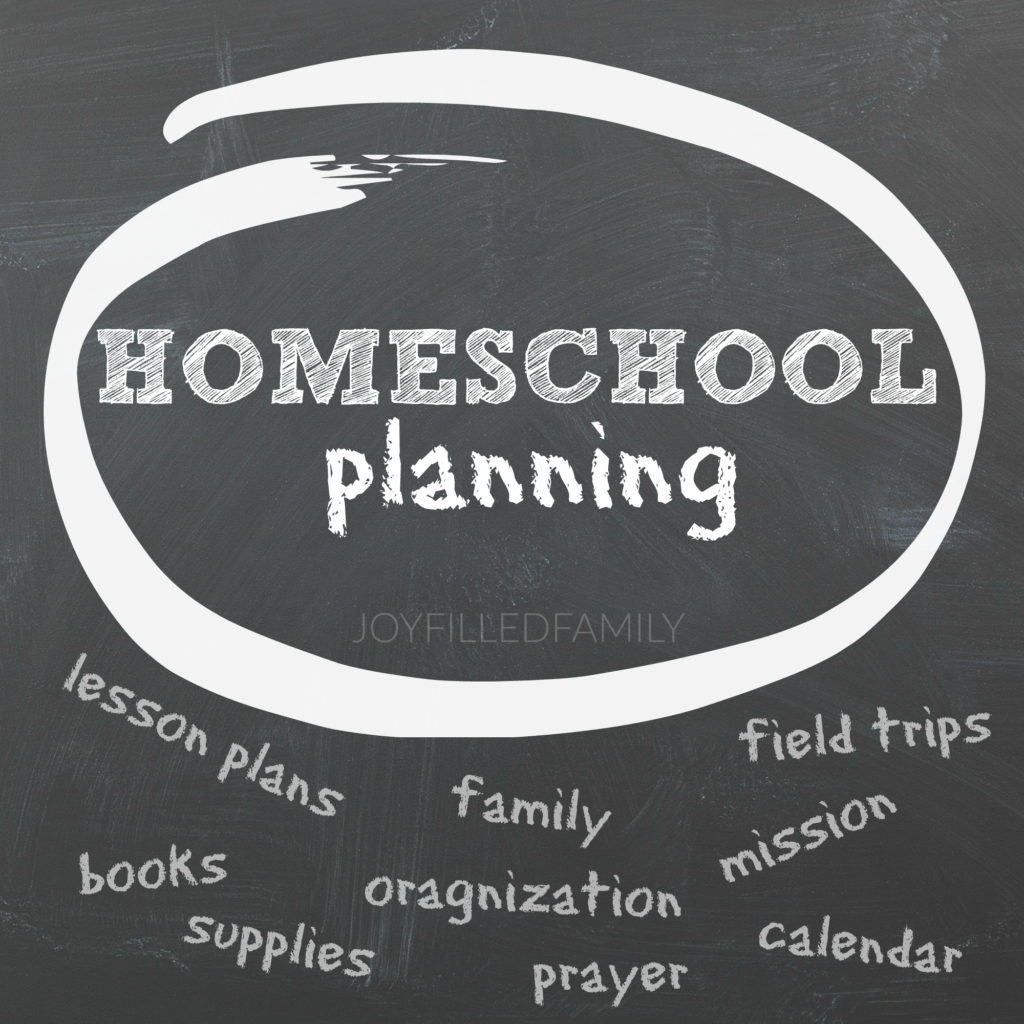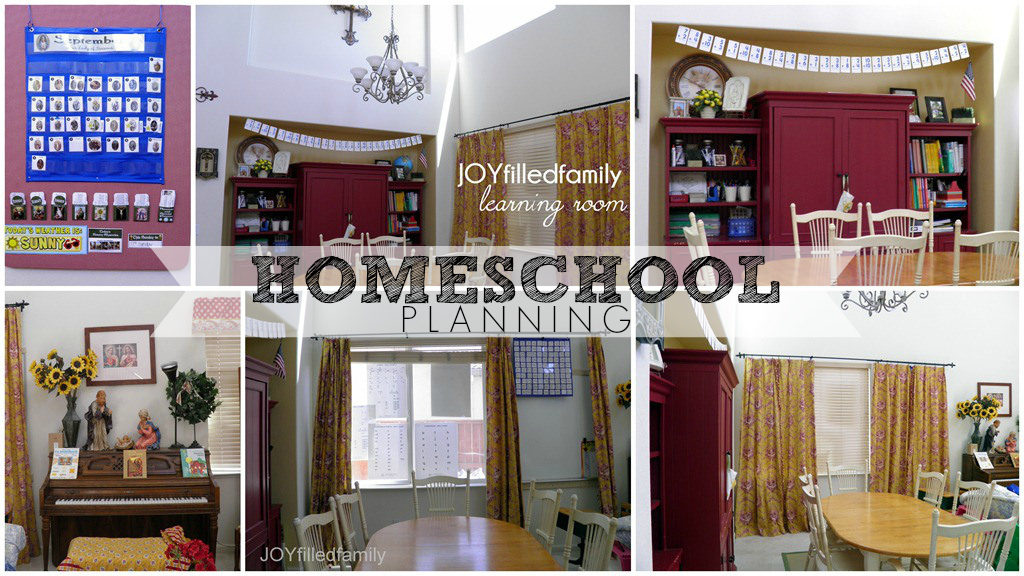Many ask what is the first step to home education. This post is a response to the #1 question that I hear.
Every year around this time we plan, reevaluate, and discern our homeschool plans. We cover it all in prayer, Home Education Novena.

There are practical things to do, planning that must be done, and items to acquire. But it can be fruitless if done without a clear homeschool mission to help guide your efforts.
Planning your homeschool without a mission can be done but the probability for chaos or unnecessary expenditures is much greater without one. Any good business would never dare to begin to invest time and money without having a clear mission and vision for their business. Why would we home educating families fall short of implementing such an effective tool?
There are a plethora of options to consider from education methods, daily routines, co-ops, classes, curricula, and extracurriculars. If you don’t have a solid direction set to help filter your options through, you will most likely end up wandering and become easily overwhelmed.
There are different ways of defining a vision, mission, objectives and goals. The vision is the “what” for home education and is often tailored per individual child, changing as needed. The goals and objectives help to achieve the vision and are often included in the actual vision set for each child.
While the mission is the “why” of home education. We know our ultimate “why,” all for the Glory of God. Our homeschool mission will expand upon this direction.

Creating the Mission
A mission statement will serve as your “why” for homeschooling. For most, this mission is ultimately a family mission since home education is a way of living.
It should be a short, meaningful summary or phrase that sums up the purpose of home educating your children. But there is really no must-have formula.
My family/home education mission statement is longer than a sentence as it’s full encompassing and we have added to it over the years. We also have a family motto that sums up our family mission & best expresses our charism.
In our earliest years, our mission was simply, …
God, Family, Education, (and everything else)!
We would cross-check all of our plans, activities, purchases with this mission to ensure that our priorities were being met and help us not to become discouraged if we never got to “everything else” or even education due to time, life circumstances (ie; mom’s health, new baby, …) or a lack of resources.
Creating your homeschool mission statement does not need to be overwhelming but it may take some time. I recommend that it be worked on with your spouse and children who are old enough to engage. Including your older children in this process is especially beneficial if you’re new to home education. It will help them become invested in their education as well as valuing the mission vs. seeing it as just words that mom/dad put together.
Once created, your home education mission will change very little if at all in the future. It is the compass that will help you navigate your home education journey, make effective decisions, and set solid goals. It is the rock that your homeschool will be built upon, helping you persevere through challenging times.
My husband has often had to redirect me to our mission when I pour out my heart of failure and frustrations to him. Often I can get blinded by all that is not just so and even fall into the worldly view of what our education and home should be. Reflecting on our mission in those times is like an immediate injection of proper perspective that helps to put my focus back on Christ.
Below are 6 steps to help you form your home education mission.

Step 1: Ask Questions
You may want to do this alone, with your spouse, a trusted mentor, spiritual director/priest, or even your children. The point is to start asking questions about what your home education does/will do and why.
Ask basic questions like these about your homeschool and family:
- What is our primary purpose to homeschool?
- What inspired us to homeschool?
- What is the end goal of our homeschool?
- What do we want our children to say at the end of the school year or at homeschool graduation?
- How do we define success of homeschool when it has all come to an end?
Take your time. You may even want to set aside two blocks of time to formulate your answers. For example, on one occasion you may want to review other homeschool mission statements or read about a particular saint that inspires you.
Then ask:
- How will our family live our call?
- What is the charism of our family?
- How could we improve upon other’s mission statements?
- Which mission statements resonate with us?
- Which maxim best serves us?
- What kind of description feels right for our family/homeschool?
The purpose of Catholic homeschooling is the teaching and training of children at home in order to preserve the Catholic Faith in the family and to preserve the Catholic Faith in our country.
Fr. John Hardon
Step 2: Brainstorm
Take the answers from the questions above and brain dump any words or short phrases that come to mind. Do not edit, just write. If you’re working

with family members, start sharing out loud. Some words or ideas may be off-the-wall while others may be real gems — write it all down and continue to share freely.
- Write down the words that pop into everyone’s head. Write exactly what is said. Do not re-word any ideas or you may miss something that would add value.
- This is only a gathering phase. You’ll end up with common feelings, words, or short phrases that make sense and resonate with you and your family.
Step 3: Shorten Your List
This step, as with the entire process of creating a mission, can serve as a fun family bonding activity. If you are working alone, simply edit the word list by crossing out the words that do not speak to your heart. If working with your spouse and/or children, make it fun! Give everyone a vote on each word or phrase. You can post the words on a board and let everyone give a star to the terms that they like best. Again, this will go a long way toward getting everyone invested in the mission.
This process will pare down that list of words to the ones that are most representative of your family and most important in what your home education will accomplish and why.
Step 4: Create a Rough Draft
This is the part of the process that the creative-writer of the family may want to take charge of. It is best done alone.
Thoughts will be summarized into one first-draft mission statement or a few first-draft mission statements can be created. The ultimate goal of this step is to get your mission statement(s) on paper. Editing can be done at a later time.
Step 5: Get Feedback
Have your spouse, children, mentor, or spiritual director review for their feedback. The mission should be easily understood and a good representation of your family. If you move forward without asking at least your spouse what they think, you may end up with something that inspired you but no one else. It is ultimately your family’s mission statement and should be reflective of your family.
Listen to the input given and do not take any critique personally.
Ask the following questions to get others to open up with honest input:
- How does this make you feel about our family/homeschool?
- What would you change in the wording?
- What is it missing?
Steps four and five may be repeated until you end up with something everyone can agree gives purpose to your family/homeschool and that they can internalize. Keep editing and getting feedback until all agree that it is complete.
Step 6: Finalize & Share
Once you’ve come to a consensus, it’s time to finalize your homeschool mission statement. This will be a consolation in itself.
Type out the final draft. I once wrote our mission statement out and did all the right things but long and behold it was lost during a move. Having a digital copy will help to ensure that you will never lose it.
Print out your homeschool mission and post in prominent places. Include it in your planners, children’s planners, give a copy to your husband, share it with tutors who help in your home, and whatever else to ensure that it is easily accessible and can be referenced on a regular basis.
Here is my family’s mission statement that serves all of our needs, including our homeschool.

Have you created a home education mission? What is your home education mission?
Additional Planning:
Once you have your family’s homeschool mission set, begin creating your vision. Remember, the vision is you your “what” for home education.
Pam Barnhill has provided a great step by step process for creating a home education vision and goal setting for each child. Click here to listen to her webinar and be on your way to creating a homeschool vision.







![JOYfilled -Sancta Familia Academy[6] JOYfilled -Sancta Familia Academy[6]](https://joyfilledfamily.com/wp-content/uploads/2013/09/JOYfilled-20-Sancta-20Familia-20-20Academy-5B6-5D_thumb-5B2-5D-300x300.jpg)

